EDSS520 Assessment 1: Audit Tool for History Teaching Skills
VerifiedAdded on 2021/04/21
|9
|2765
|134
Homework Assignment
AI Summary
This assignment, designed as an audit tool for history teachers, evaluates the candidate's understanding of the Australian Curriculum: History for Years 7-10, requiring the development of a course of study with rationale. It assesses content knowledge across various depth studies, rating the candidate's understanding and providing pre-tests to evaluate skill application. The assignment further explores procedural concepts like change and continuity, cause and effect, evidence, perspectives, historical interpretations, and empathy, with practical classroom activity examples. Source analysis skills are examined through a Year 10 test. A reflection component encourages self-assessment of strengths, challenges, opportunities for improvement, and contextualizing historical skills in the contemporary society, highlighting the dynamic nature of modern society and its relevance to historical concepts. The assignment aims to provide a comprehensive evaluation of a history teacher's skills, knowledge, and conceptual understanding.
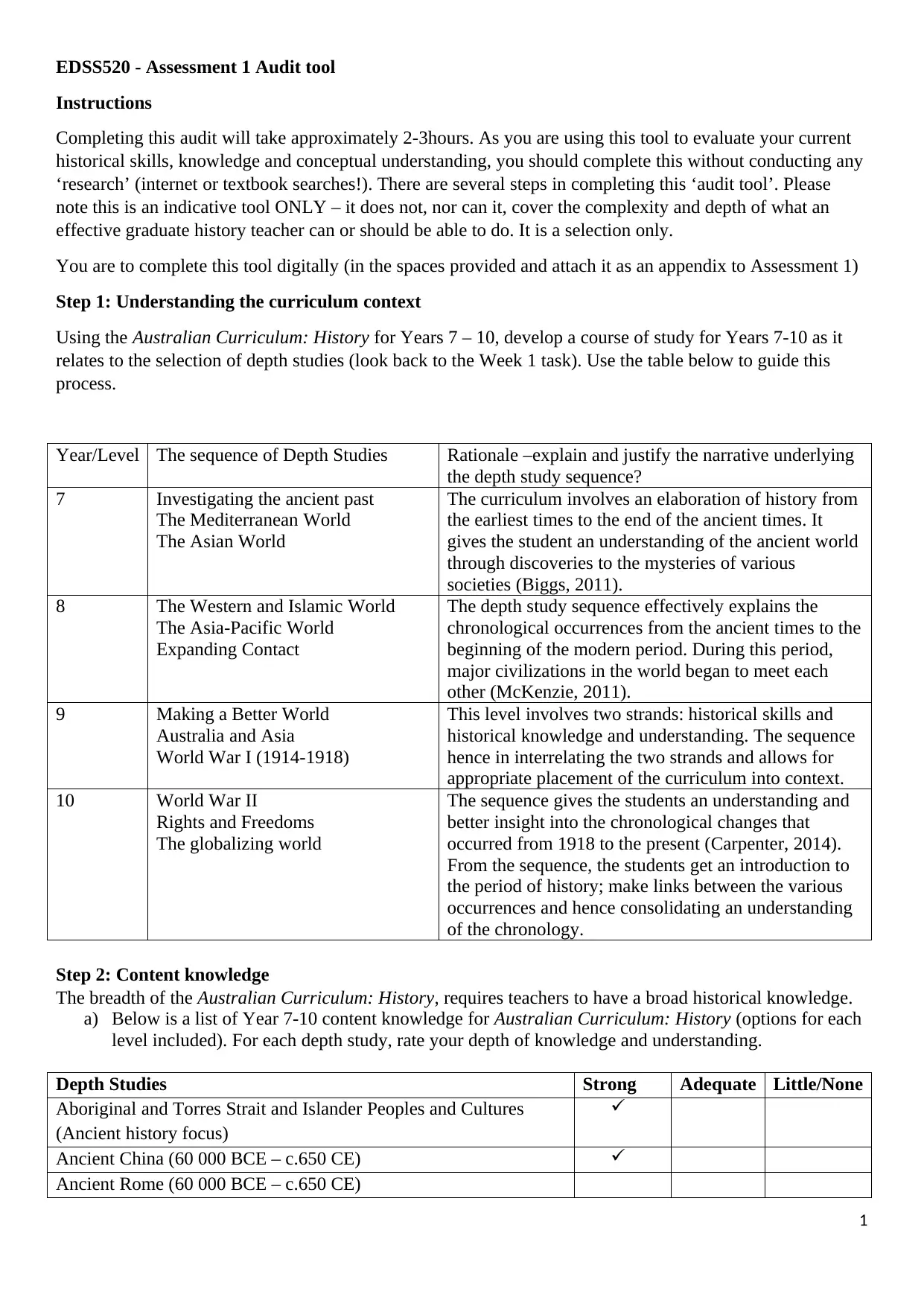
EDSS520 - Assessment 1 Audit tool
Instructions
Completing this audit will take approximately 2-3hours. As you are using this tool to evaluate your current
historical skills, knowledge and conceptual understanding, you should complete this without conducting any
‘research’ (internet or textbook searches!). There are several steps in completing this ‘audit tool’. Please
note this is an indicative tool ONLY – it does not, nor can it, cover the complexity and depth of what an
effective graduate history teacher can or should be able to do. It is a selection only.
You are to complete this tool digitally (in the spaces provided and attach it as an appendix to Assessment 1)
Step 1: Understanding the curriculum context
Using the Australian Curriculum: History for Years 7 – 10, develop a course of study for Years 7-10 as it
relates to the selection of depth studies (look back to the Week 1 task). Use the table below to guide this
process.
Year/Level The sequence of Depth Studies Rationale –explain and justify the narrative underlying
the depth study sequence?
7 Investigating the ancient past
The Mediterranean World
The Asian World
The curriculum involves an elaboration of history from
the earliest times to the end of the ancient times. It
gives the student an understanding of the ancient world
through discoveries to the mysteries of various
societies (Biggs, 2011).
8 The Western and Islamic World
The Asia-Pacific World
Expanding Contact
The depth study sequence effectively explains the
chronological occurrences from the ancient times to the
beginning of the modern period. During this period,
major civilizations in the world began to meet each
other (McKenzie, 2011).
9 Making a Better World
Australia and Asia
World War I (1914-1918)
This level involves two strands: historical skills and
historical knowledge and understanding. The sequence
hence in interrelating the two strands and allows for
appropriate placement of the curriculum into context.
10 World War II
Rights and Freedoms
The globalizing world
The sequence gives the students an understanding and
better insight into the chronological changes that
occurred from 1918 to the present (Carpenter, 2014).
From the sequence, the students get an introduction to
the period of history; make links between the various
occurrences and hence consolidating an understanding
of the chronology.
Step 2: Content knowledge
The breadth of the Australian Curriculum: History, requires teachers to have a broad historical knowledge.
a) Below is a list of Year 7-10 content knowledge for Australian Curriculum: History (options for each
level included). For each depth study, rate your depth of knowledge and understanding.
Depth Studies Strong Adequate Little/None
Aboriginal and Torres Strait and Islander Peoples and Cultures
(Ancient history focus)
Ancient China (60 000 BCE – c.650 CE)
Ancient Rome (60 000 BCE – c.650 CE)
1
Instructions
Completing this audit will take approximately 2-3hours. As you are using this tool to evaluate your current
historical skills, knowledge and conceptual understanding, you should complete this without conducting any
‘research’ (internet or textbook searches!). There are several steps in completing this ‘audit tool’. Please
note this is an indicative tool ONLY – it does not, nor can it, cover the complexity and depth of what an
effective graduate history teacher can or should be able to do. It is a selection only.
You are to complete this tool digitally (in the spaces provided and attach it as an appendix to Assessment 1)
Step 1: Understanding the curriculum context
Using the Australian Curriculum: History for Years 7 – 10, develop a course of study for Years 7-10 as it
relates to the selection of depth studies (look back to the Week 1 task). Use the table below to guide this
process.
Year/Level The sequence of Depth Studies Rationale –explain and justify the narrative underlying
the depth study sequence?
7 Investigating the ancient past
The Mediterranean World
The Asian World
The curriculum involves an elaboration of history from
the earliest times to the end of the ancient times. It
gives the student an understanding of the ancient world
through discoveries to the mysteries of various
societies (Biggs, 2011).
8 The Western and Islamic World
The Asia-Pacific World
Expanding Contact
The depth study sequence effectively explains the
chronological occurrences from the ancient times to the
beginning of the modern period. During this period,
major civilizations in the world began to meet each
other (McKenzie, 2011).
9 Making a Better World
Australia and Asia
World War I (1914-1918)
This level involves two strands: historical skills and
historical knowledge and understanding. The sequence
hence in interrelating the two strands and allows for
appropriate placement of the curriculum into context.
10 World War II
Rights and Freedoms
The globalizing world
The sequence gives the students an understanding and
better insight into the chronological changes that
occurred from 1918 to the present (Carpenter, 2014).
From the sequence, the students get an introduction to
the period of history; make links between the various
occurrences and hence consolidating an understanding
of the chronology.
Step 2: Content knowledge
The breadth of the Australian Curriculum: History, requires teachers to have a broad historical knowledge.
a) Below is a list of Year 7-10 content knowledge for Australian Curriculum: History (options for each
level included). For each depth study, rate your depth of knowledge and understanding.
Depth Studies Strong Adequate Little/None
Aboriginal and Torres Strait and Islander Peoples and Cultures
(Ancient history focus)
Ancient China (60 000 BCE – c.650 CE)
Ancient Rome (60 000 BCE – c.650 CE)
1
Paraphrase This Document
Need a fresh take? Get an instant paraphrase of this document with our AI Paraphraser

Ancient Egypt (60 000 BCE – c.650 CE)
Ancient India (60 000 BCE – c.650 CE)
Ancient China (60 000 BCE – c.650 CE)
Medieval Europe (c.590 – c.1500)
The Vikings (c.790 – c.1066)
The Ottoman Empire (c.1299 – c.1683)
Angkor/Khmer Empire (c.802 – c.1431)
Mongol Expansion (c.1206 – c.1368)
Japan under the Shoguns (c.794 – 1867)
The Polynesian expansion across the Pacific (c.700 – 1756)
Renaissance Italy (c.1400 – c.1600)
The Spanish Conquest of the Americas (c.1492 – c.1572)
Industrial Revolution (1750 – 1914)
Australia and/or an Asian society in the period 1750 – 1918
Australia at War: WWI
Australia at War: WWII
2
Ancient India (60 000 BCE – c.650 CE)
Ancient China (60 000 BCE – c.650 CE)
Medieval Europe (c.590 – c.1500)
The Vikings (c.790 – c.1066)
The Ottoman Empire (c.1299 – c.1683)
Angkor/Khmer Empire (c.802 – c.1431)
Mongol Expansion (c.1206 – c.1368)
Japan under the Shoguns (c.794 – 1867)
The Polynesian expansion across the Pacific (c.700 – 1756)
Renaissance Italy (c.1400 – c.1600)
The Spanish Conquest of the Americas (c.1492 – c.1572)
Industrial Revolution (1750 – 1914)
Australia and/or an Asian society in the period 1750 – 1918
Australia at War: WWI
Australia at War: WWII
2
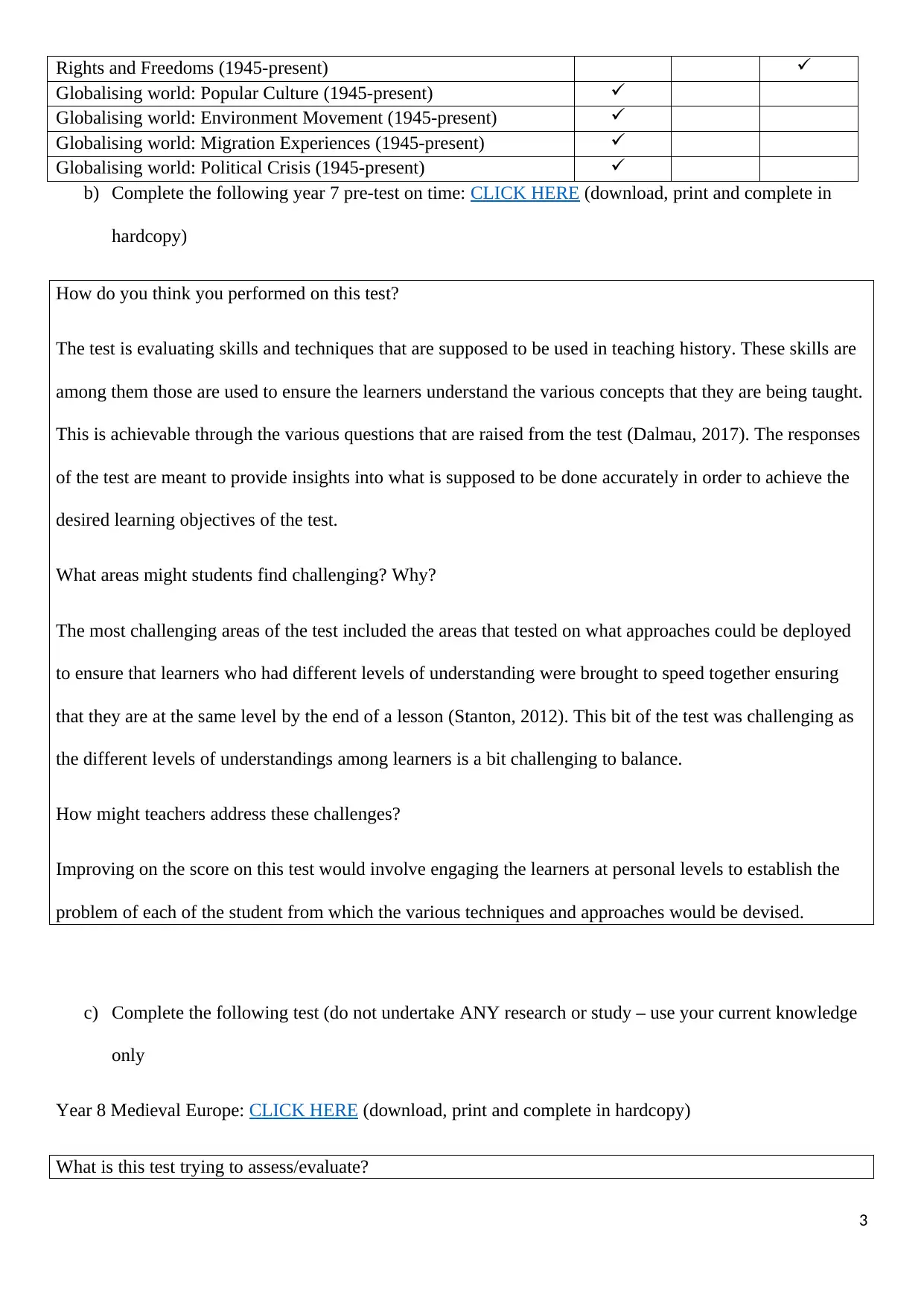
Rights and Freedoms (1945-present)
Globalising world: Popular Culture (1945-present)
Globalising world: Environment Movement (1945-present)
Globalising world: Migration Experiences (1945-present)
Globalising world: Political Crisis (1945-present)
b) Complete the following year 7 pre-test on time: CLICK HERE (download, print and complete in
hardcopy)
How do you think you performed on this test?
The test is evaluating skills and techniques that are supposed to be used in teaching history. These skills are
among them those are used to ensure the learners understand the various concepts that they are being taught.
This is achievable through the various questions that are raised from the test (Dalmau, 2017). The responses
of the test are meant to provide insights into what is supposed to be done accurately in order to achieve the
desired learning objectives of the test.
What areas might students find challenging? Why?
The most challenging areas of the test included the areas that tested on what approaches could be deployed
to ensure that learners who had different levels of understanding were brought to speed together ensuring
that they are at the same level by the end of a lesson (Stanton, 2012). This bit of the test was challenging as
the different levels of understandings among learners is a bit challenging to balance.
How might teachers address these challenges?
Improving on the score on this test would involve engaging the learners at personal levels to establish the
problem of each of the student from which the various techniques and approaches would be devised.
c) Complete the following test (do not undertake ANY research or study – use your current knowledge
only
Year 8 Medieval Europe: CLICK HERE (download, print and complete in hardcopy)
What is this test trying to assess/evaluate?
3
Globalising world: Popular Culture (1945-present)
Globalising world: Environment Movement (1945-present)
Globalising world: Migration Experiences (1945-present)
Globalising world: Political Crisis (1945-present)
b) Complete the following year 7 pre-test on time: CLICK HERE (download, print and complete in
hardcopy)
How do you think you performed on this test?
The test is evaluating skills and techniques that are supposed to be used in teaching history. These skills are
among them those are used to ensure the learners understand the various concepts that they are being taught.
This is achievable through the various questions that are raised from the test (Dalmau, 2017). The responses
of the test are meant to provide insights into what is supposed to be done accurately in order to achieve the
desired learning objectives of the test.
What areas might students find challenging? Why?
The most challenging areas of the test included the areas that tested on what approaches could be deployed
to ensure that learners who had different levels of understanding were brought to speed together ensuring
that they are at the same level by the end of a lesson (Stanton, 2012). This bit of the test was challenging as
the different levels of understandings among learners is a bit challenging to balance.
How might teachers address these challenges?
Improving on the score on this test would involve engaging the learners at personal levels to establish the
problem of each of the student from which the various techniques and approaches would be devised.
c) Complete the following test (do not undertake ANY research or study – use your current knowledge
only
Year 8 Medieval Europe: CLICK HERE (download, print and complete in hardcopy)
What is this test trying to assess/evaluate?
3
⊘ This is a preview!⊘
Do you want full access?
Subscribe today to unlock all pages.

Trusted by 1+ million students worldwide
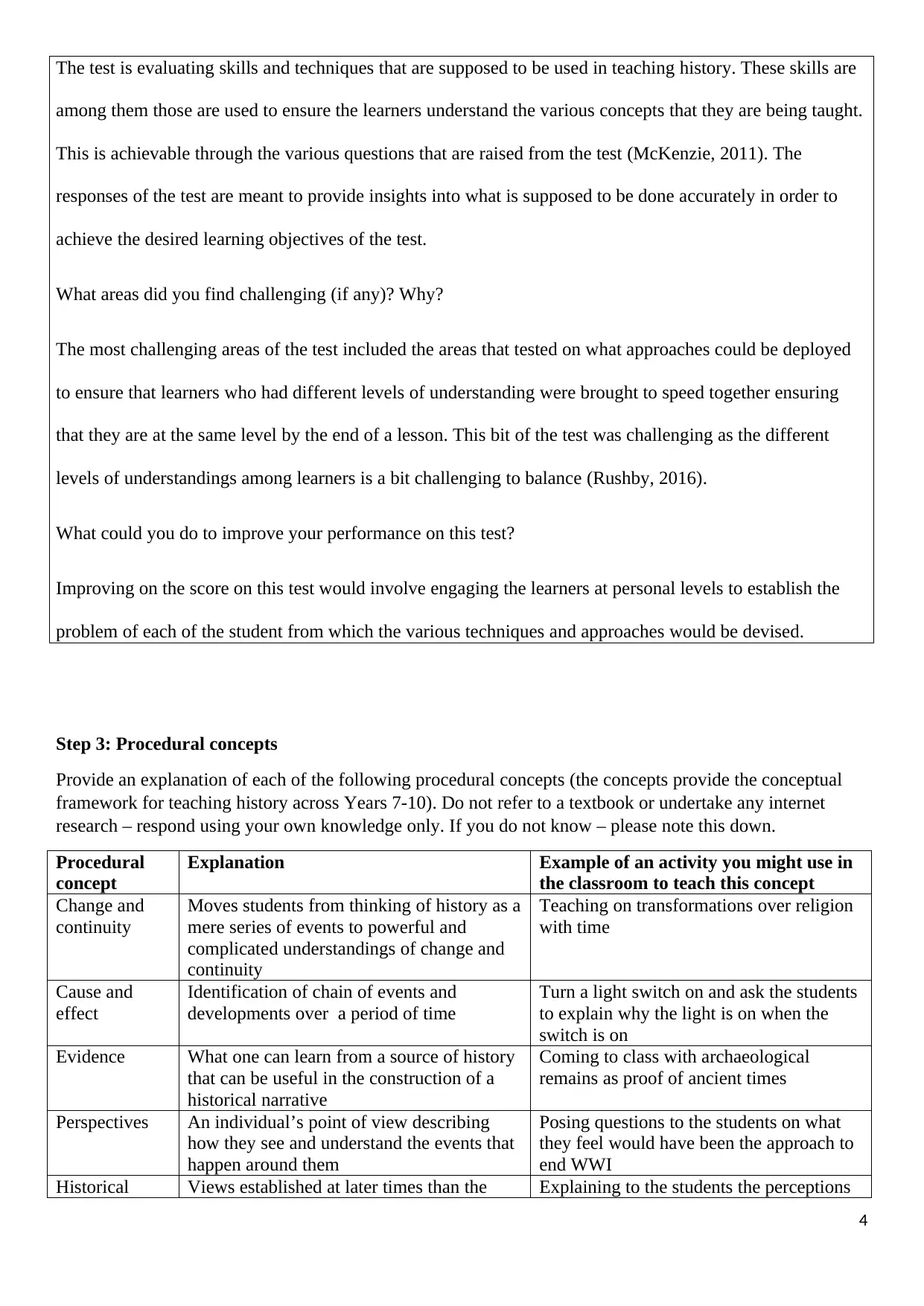
The test is evaluating skills and techniques that are supposed to be used in teaching history. These skills are
among them those are used to ensure the learners understand the various concepts that they are being taught.
This is achievable through the various questions that are raised from the test (McKenzie, 2011). The
responses of the test are meant to provide insights into what is supposed to be done accurately in order to
achieve the desired learning objectives of the test.
What areas did you find challenging (if any)? Why?
The most challenging areas of the test included the areas that tested on what approaches could be deployed
to ensure that learners who had different levels of understanding were brought to speed together ensuring
that they are at the same level by the end of a lesson. This bit of the test was challenging as the different
levels of understandings among learners is a bit challenging to balance (Rushby, 2016).
What could you do to improve your performance on this test?
Improving on the score on this test would involve engaging the learners at personal levels to establish the
problem of each of the student from which the various techniques and approaches would be devised.
Step 3: Procedural concepts
Provide an explanation of each of the following procedural concepts (the concepts provide the conceptual
framework for teaching history across Years 7-10). Do not refer to a textbook or undertake any internet
research – respond using your own knowledge only. If you do not know – please note this down.
Procedural
concept
Explanation Example of an activity you might use in
the classroom to teach this concept
Change and
continuity
Moves students from thinking of history as a
mere series of events to powerful and
complicated understandings of change and
continuity
Teaching on transformations over religion
with time
Cause and
effect
Identification of chain of events and
developments over a period of time
Turn a light switch on and ask the students
to explain why the light is on when the
switch is on
Evidence What one can learn from a source of history
that can be useful in the construction of a
historical narrative
Coming to class with archaeological
remains as proof of ancient times
Perspectives An individual’s point of view describing
how they see and understand the events that
happen around them
Posing questions to the students on what
they feel would have been the approach to
end WWI
Historical Views established at later times than the Explaining to the students the perceptions
4
among them those are used to ensure the learners understand the various concepts that they are being taught.
This is achievable through the various questions that are raised from the test (McKenzie, 2011). The
responses of the test are meant to provide insights into what is supposed to be done accurately in order to
achieve the desired learning objectives of the test.
What areas did you find challenging (if any)? Why?
The most challenging areas of the test included the areas that tested on what approaches could be deployed
to ensure that learners who had different levels of understanding were brought to speed together ensuring
that they are at the same level by the end of a lesson. This bit of the test was challenging as the different
levels of understandings among learners is a bit challenging to balance (Rushby, 2016).
What could you do to improve your performance on this test?
Improving on the score on this test would involve engaging the learners at personal levels to establish the
problem of each of the student from which the various techniques and approaches would be devised.
Step 3: Procedural concepts
Provide an explanation of each of the following procedural concepts (the concepts provide the conceptual
framework for teaching history across Years 7-10). Do not refer to a textbook or undertake any internet
research – respond using your own knowledge only. If you do not know – please note this down.
Procedural
concept
Explanation Example of an activity you might use in
the classroom to teach this concept
Change and
continuity
Moves students from thinking of history as a
mere series of events to powerful and
complicated understandings of change and
continuity
Teaching on transformations over religion
with time
Cause and
effect
Identification of chain of events and
developments over a period of time
Turn a light switch on and ask the students
to explain why the light is on when the
switch is on
Evidence What one can learn from a source of history
that can be useful in the construction of a
historical narrative
Coming to class with archaeological
remains as proof of ancient times
Perspectives An individual’s point of view describing
how they see and understand the events that
happen around them
Posing questions to the students on what
they feel would have been the approach to
end WWI
Historical Views established at later times than the Explaining to the students the perceptions
4
Paraphrase This Document
Need a fresh take? Get an instant paraphrase of this document with our AI Paraphraser

interpretations events occurred of various authors and scholars on the
certain topic
Empathy Engaging with the past thought Asking the students to describe memorable
episodes
5
certain topic
Empathy Engaging with the past thought Asking the students to describe memorable
episodes
5
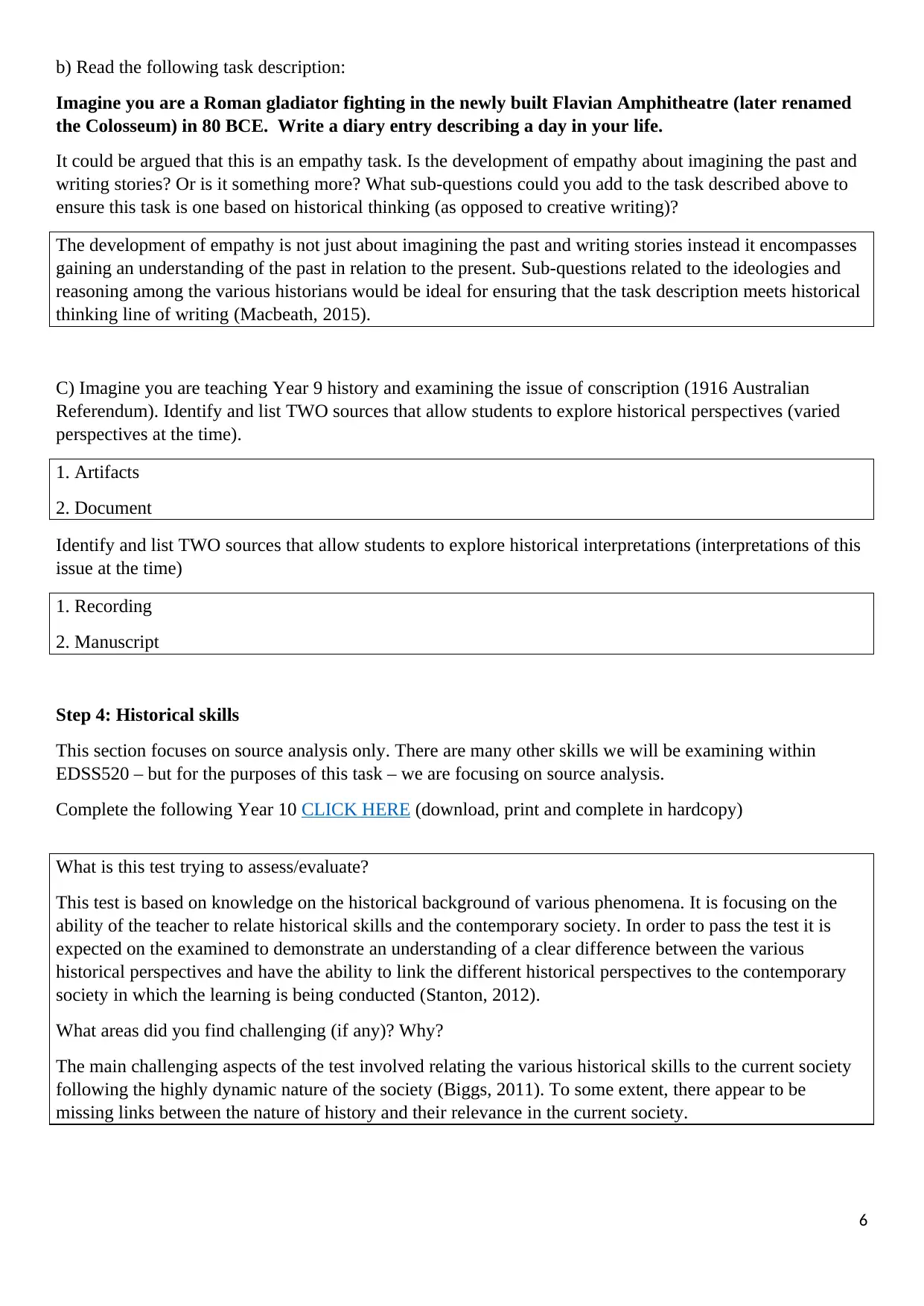
b) Read the following task description:
Imagine you are a Roman gladiator fighting in the newly built Flavian Amphitheatre (later renamed
the Colosseum) in 80 BCE. Write a diary entry describing a day in your life.
It could be argued that this is an empathy task. Is the development of empathy about imagining the past and
writing stories? Or is it something more? What sub-questions could you add to the task described above to
ensure this task is one based on historical thinking (as opposed to creative writing)?
The development of empathy is not just about imagining the past and writing stories instead it encompasses
gaining an understanding of the past in relation to the present. Sub-questions related to the ideologies and
reasoning among the various historians would be ideal for ensuring that the task description meets historical
thinking line of writing (Macbeath, 2015).
C) Imagine you are teaching Year 9 history and examining the issue of conscription (1916 Australian
Referendum). Identify and list TWO sources that allow students to explore historical perspectives (varied
perspectives at the time).
1. Artifacts
2. Document
Identify and list TWO sources that allow students to explore historical interpretations (interpretations of this
issue at the time)
1. Recording
2. Manuscript
Step 4: Historical skills
This section focuses on source analysis only. There are many other skills we will be examining within
EDSS520 – but for the purposes of this task – we are focusing on source analysis.
Complete the following Year 10 CLICK HERE (download, print and complete in hardcopy)
What is this test trying to assess/evaluate?
This test is based on knowledge on the historical background of various phenomena. It is focusing on the
ability of the teacher to relate historical skills and the contemporary society. In order to pass the test it is
expected on the examined to demonstrate an understanding of a clear difference between the various
historical perspectives and have the ability to link the different historical perspectives to the contemporary
society in which the learning is being conducted (Stanton, 2012).
What areas did you find challenging (if any)? Why?
The main challenging aspects of the test involved relating the various historical skills to the current society
following the highly dynamic nature of the society (Biggs, 2011). To some extent, there appear to be
missing links between the nature of history and their relevance in the current society.
6
Imagine you are a Roman gladiator fighting in the newly built Flavian Amphitheatre (later renamed
the Colosseum) in 80 BCE. Write a diary entry describing a day in your life.
It could be argued that this is an empathy task. Is the development of empathy about imagining the past and
writing stories? Or is it something more? What sub-questions could you add to the task described above to
ensure this task is one based on historical thinking (as opposed to creative writing)?
The development of empathy is not just about imagining the past and writing stories instead it encompasses
gaining an understanding of the past in relation to the present. Sub-questions related to the ideologies and
reasoning among the various historians would be ideal for ensuring that the task description meets historical
thinking line of writing (Macbeath, 2015).
C) Imagine you are teaching Year 9 history and examining the issue of conscription (1916 Australian
Referendum). Identify and list TWO sources that allow students to explore historical perspectives (varied
perspectives at the time).
1. Artifacts
2. Document
Identify and list TWO sources that allow students to explore historical interpretations (interpretations of this
issue at the time)
1. Recording
2. Manuscript
Step 4: Historical skills
This section focuses on source analysis only. There are many other skills we will be examining within
EDSS520 – but for the purposes of this task – we are focusing on source analysis.
Complete the following Year 10 CLICK HERE (download, print and complete in hardcopy)
What is this test trying to assess/evaluate?
This test is based on knowledge on the historical background of various phenomena. It is focusing on the
ability of the teacher to relate historical skills and the contemporary society. In order to pass the test it is
expected on the examined to demonstrate an understanding of a clear difference between the various
historical perspectives and have the ability to link the different historical perspectives to the contemporary
society in which the learning is being conducted (Stanton, 2012).
What areas did you find challenging (if any)? Why?
The main challenging aspects of the test involved relating the various historical skills to the current society
following the highly dynamic nature of the society (Biggs, 2011). To some extent, there appear to be
missing links between the nature of history and their relevance in the current society.
6
⊘ This is a preview!⊘
Do you want full access?
Subscribe today to unlock all pages.

Trusted by 1+ million students worldwide
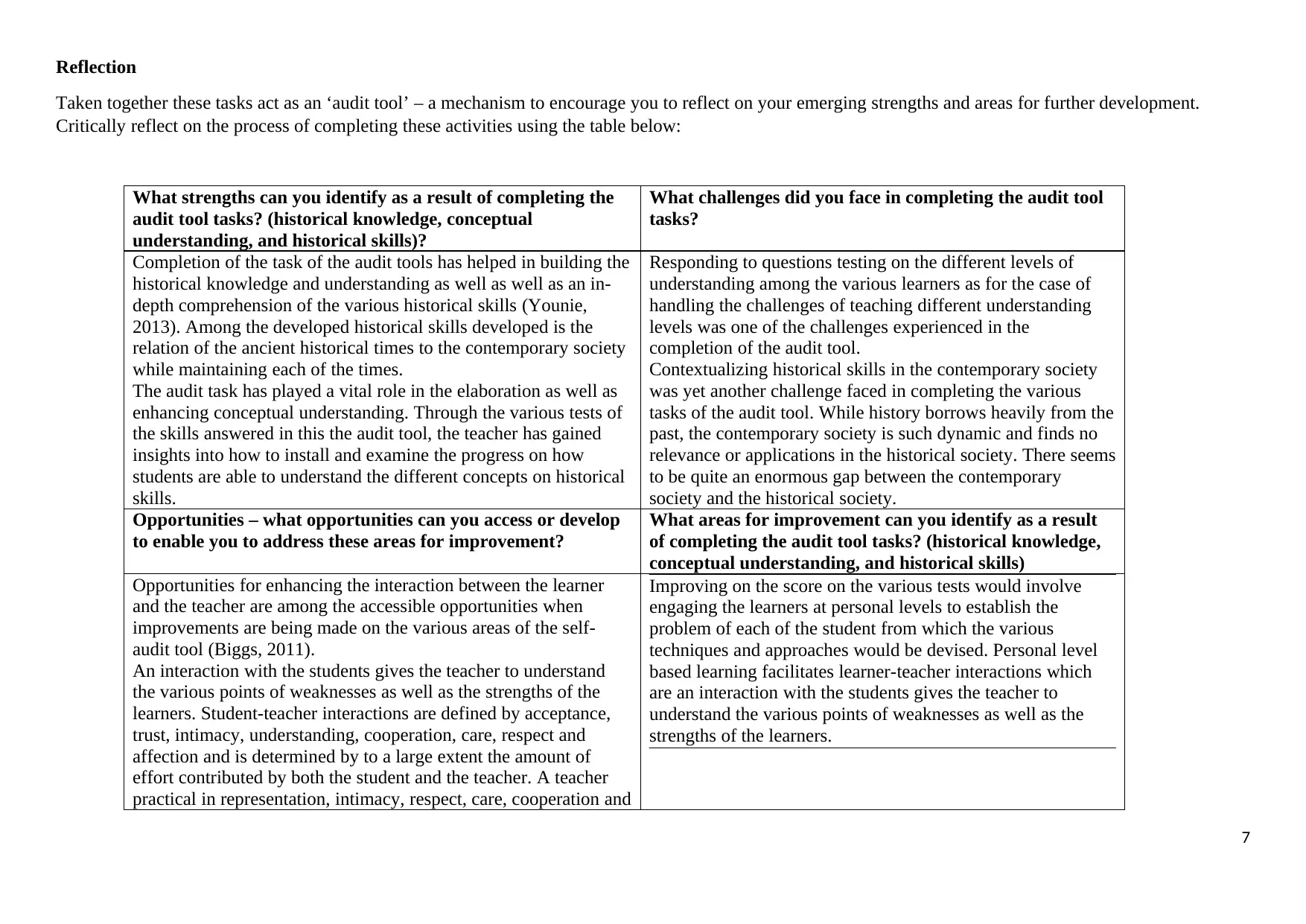
Reflection
Taken together these tasks act as an ‘audit tool’ – a mechanism to encourage you to reflect on your emerging strengths and areas for further development.
Critically reflect on the process of completing these activities using the table below:
What strengths can you identify as a result of completing the
audit tool tasks? (historical knowledge, conceptual
understanding, and historical skills)?
What challenges did you face in completing the audit tool
tasks?
Completion of the task of the audit tools has helped in building the
historical knowledge and understanding as well as well as an in-
depth comprehension of the various historical skills (Younie,
2013). Among the developed historical skills developed is the
relation of the ancient historical times to the contemporary society
while maintaining each of the times.
The audit task has played a vital role in the elaboration as well as
enhancing conceptual understanding. Through the various tests of
the skills answered in this the audit tool, the teacher has gained
insights into how to install and examine the progress on how
students are able to understand the different concepts on historical
skills.
Responding to questions testing on the different levels of
understanding among the various learners as for the case of
handling the challenges of teaching different understanding
levels was one of the challenges experienced in the
completion of the audit tool.
Contextualizing historical skills in the contemporary society
was yet another challenge faced in completing the various
tasks of the audit tool. While history borrows heavily from the
past, the contemporary society is such dynamic and finds no
relevance or applications in the historical society. There seems
to be quite an enormous gap between the contemporary
society and the historical society.
Opportunities – what opportunities can you access or develop
to enable you to address these areas for improvement?
What areas for improvement can you identify as a result
of completing the audit tool tasks? (historical knowledge,
conceptual understanding, and historical skills)
Opportunities for enhancing the interaction between the learner
and the teacher are among the accessible opportunities when
improvements are being made on the various areas of the self-
audit tool (Biggs, 2011).
An interaction with the students gives the teacher to understand
the various points of weaknesses as well as the strengths of the
learners. Student-teacher interactions are defined by acceptance,
trust, intimacy, understanding, cooperation, care, respect and
affection and is determined by to a large extent the amount of
effort contributed by both the student and the teacher. A teacher
practical in representation, intimacy, respect, care, cooperation and
Improving on the score on the various tests would involve
engaging the learners at personal levels to establish the
problem of each of the student from which the various
techniques and approaches would be devised. Personal level
based learning facilitates learner-teacher interactions which
are an interaction with the students gives the teacher to
understand the various points of weaknesses as well as the
strengths of the learners.
7
Taken together these tasks act as an ‘audit tool’ – a mechanism to encourage you to reflect on your emerging strengths and areas for further development.
Critically reflect on the process of completing these activities using the table below:
What strengths can you identify as a result of completing the
audit tool tasks? (historical knowledge, conceptual
understanding, and historical skills)?
What challenges did you face in completing the audit tool
tasks?
Completion of the task of the audit tools has helped in building the
historical knowledge and understanding as well as well as an in-
depth comprehension of the various historical skills (Younie,
2013). Among the developed historical skills developed is the
relation of the ancient historical times to the contemporary society
while maintaining each of the times.
The audit task has played a vital role in the elaboration as well as
enhancing conceptual understanding. Through the various tests of
the skills answered in this the audit tool, the teacher has gained
insights into how to install and examine the progress on how
students are able to understand the different concepts on historical
skills.
Responding to questions testing on the different levels of
understanding among the various learners as for the case of
handling the challenges of teaching different understanding
levels was one of the challenges experienced in the
completion of the audit tool.
Contextualizing historical skills in the contemporary society
was yet another challenge faced in completing the various
tasks of the audit tool. While history borrows heavily from the
past, the contemporary society is such dynamic and finds no
relevance or applications in the historical society. There seems
to be quite an enormous gap between the contemporary
society and the historical society.
Opportunities – what opportunities can you access or develop
to enable you to address these areas for improvement?
What areas for improvement can you identify as a result
of completing the audit tool tasks? (historical knowledge,
conceptual understanding, and historical skills)
Opportunities for enhancing the interaction between the learner
and the teacher are among the accessible opportunities when
improvements are being made on the various areas of the self-
audit tool (Biggs, 2011).
An interaction with the students gives the teacher to understand
the various points of weaknesses as well as the strengths of the
learners. Student-teacher interactions are defined by acceptance,
trust, intimacy, understanding, cooperation, care, respect and
affection and is determined by to a large extent the amount of
effort contributed by both the student and the teacher. A teacher
practical in representation, intimacy, respect, care, cooperation and
Improving on the score on the various tests would involve
engaging the learners at personal levels to establish the
problem of each of the student from which the various
techniques and approaches would be devised. Personal level
based learning facilitates learner-teacher interactions which
are an interaction with the students gives the teacher to
understand the various points of weaknesses as well as the
strengths of the learners.
7
Paraphrase This Document
Need a fresh take? Get an instant paraphrase of this document with our AI Paraphraser
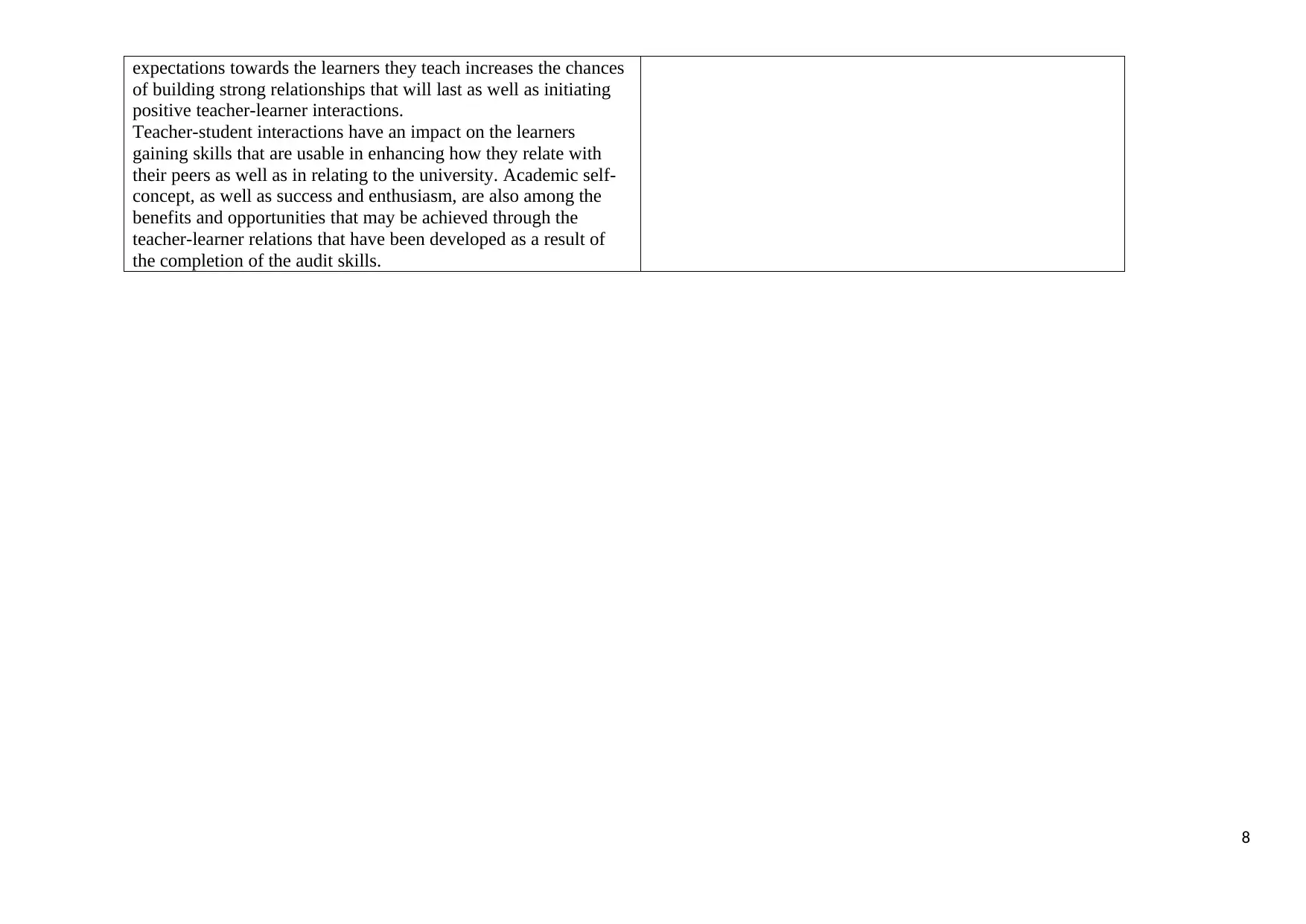
expectations towards the learners they teach increases the chances
of building strong relationships that will last as well as initiating
positive teacher-learner interactions.
Teacher-student interactions have an impact on the learners
gaining skills that are usable in enhancing how they relate with
their peers as well as in relating to the university. Academic self-
concept, as well as success and enthusiasm, are also among the
benefits and opportunities that may be achieved through the
teacher-learner relations that have been developed as a result of
the completion of the audit skills.
8
of building strong relationships that will last as well as initiating
positive teacher-learner interactions.
Teacher-student interactions have an impact on the learners
gaining skills that are usable in enhancing how they relate with
their peers as well as in relating to the university. Academic self-
concept, as well as success and enthusiasm, are also among the
benefits and opportunities that may be achieved through the
teacher-learner relations that have been developed as a result of
the completion of the audit skills.
8
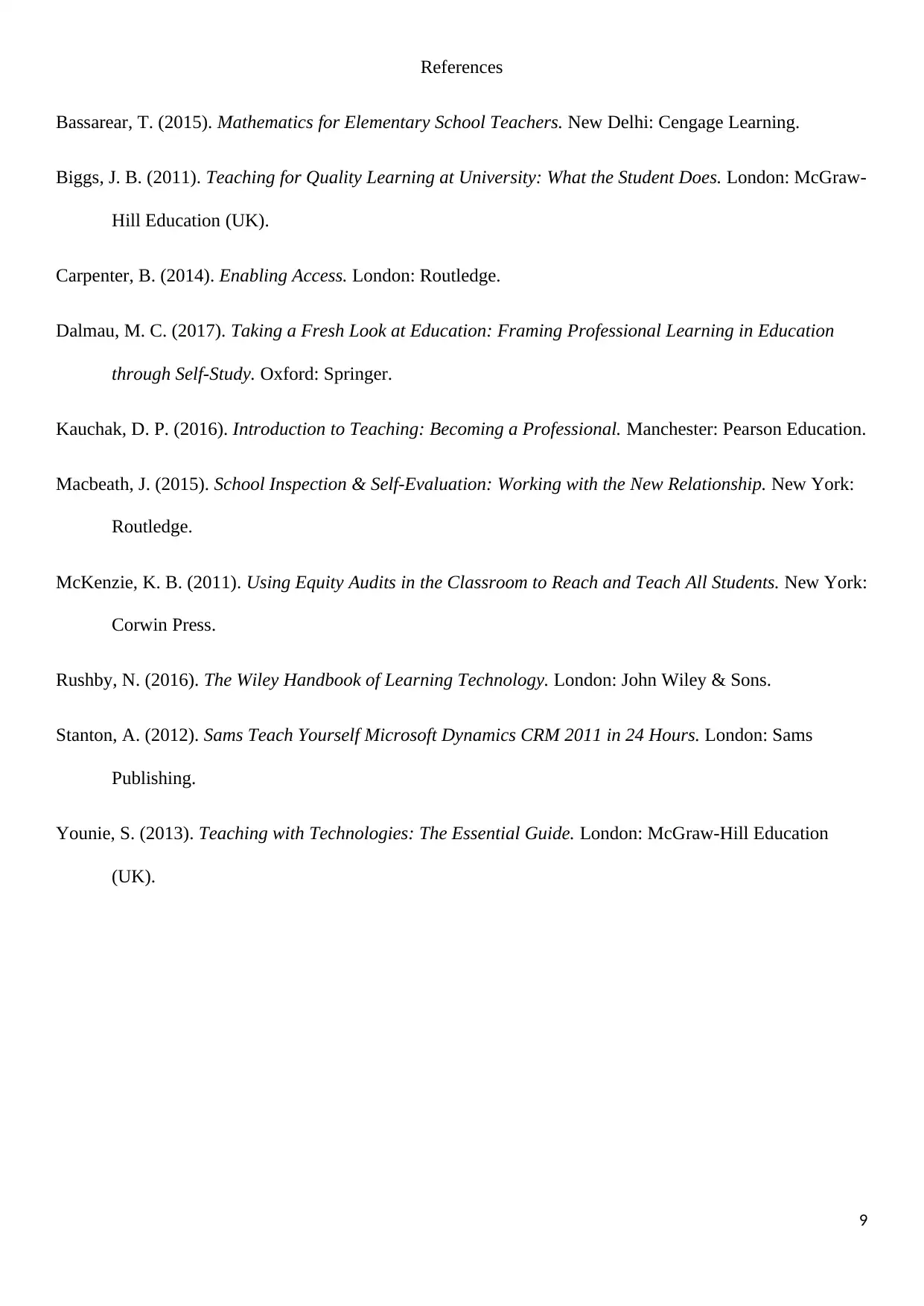
References
Bassarear, T. (2015). Mathematics for Elementary School Teachers. New Delhi: Cengage Learning.
Biggs, J. B. (2011). Teaching for Quality Learning at University: What the Student Does. London: McGraw-
Hill Education (UK).
Carpenter, B. (2014). Enabling Access. London: Routledge.
Dalmau, M. C. (2017). Taking a Fresh Look at Education: Framing Professional Learning in Education
through Self-Study. Oxford: Springer.
Kauchak, D. P. (2016). Introduction to Teaching: Becoming a Professional. Manchester: Pearson Education.
Macbeath, J. (2015). School Inspection & Self-Evaluation: Working with the New Relationship. New York:
Routledge.
McKenzie, K. B. (2011). Using Equity Audits in the Classroom to Reach and Teach All Students. New York:
Corwin Press.
Rushby, N. (2016). The Wiley Handbook of Learning Technology. London: John Wiley & Sons.
Stanton, A. (2012). Sams Teach Yourself Microsoft Dynamics CRM 2011 in 24 Hours. London: Sams
Publishing.
Younie, S. (2013). Teaching with Technologies: The Essential Guide. London: McGraw-Hill Education
(UK).
9
Bassarear, T. (2015). Mathematics for Elementary School Teachers. New Delhi: Cengage Learning.
Biggs, J. B. (2011). Teaching for Quality Learning at University: What the Student Does. London: McGraw-
Hill Education (UK).
Carpenter, B. (2014). Enabling Access. London: Routledge.
Dalmau, M. C. (2017). Taking a Fresh Look at Education: Framing Professional Learning in Education
through Self-Study. Oxford: Springer.
Kauchak, D. P. (2016). Introduction to Teaching: Becoming a Professional. Manchester: Pearson Education.
Macbeath, J. (2015). School Inspection & Self-Evaluation: Working with the New Relationship. New York:
Routledge.
McKenzie, K. B. (2011). Using Equity Audits in the Classroom to Reach and Teach All Students. New York:
Corwin Press.
Rushby, N. (2016). The Wiley Handbook of Learning Technology. London: John Wiley & Sons.
Stanton, A. (2012). Sams Teach Yourself Microsoft Dynamics CRM 2011 in 24 Hours. London: Sams
Publishing.
Younie, S. (2013). Teaching with Technologies: The Essential Guide. London: McGraw-Hill Education
(UK).
9
⊘ This is a preview!⊘
Do you want full access?
Subscribe today to unlock all pages.

Trusted by 1+ million students worldwide
1 out of 9
Your All-in-One AI-Powered Toolkit for Academic Success.
+13062052269
info@desklib.com
Available 24*7 on WhatsApp / Email
![[object Object]](/_next/static/media/star-bottom.7253800d.svg)
Unlock your academic potential
Copyright © 2020–2025 A2Z Services. All Rights Reserved. Developed and managed by ZUCOL.
